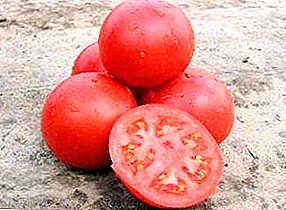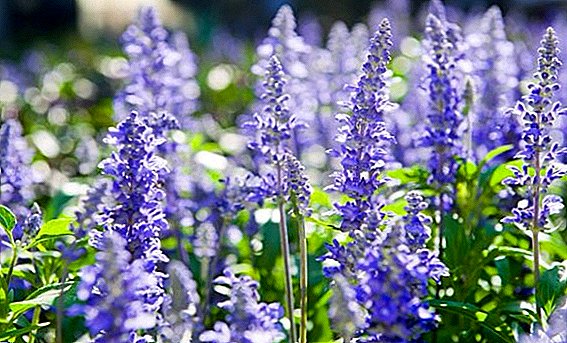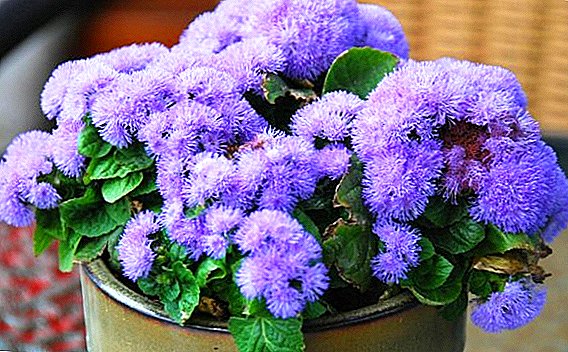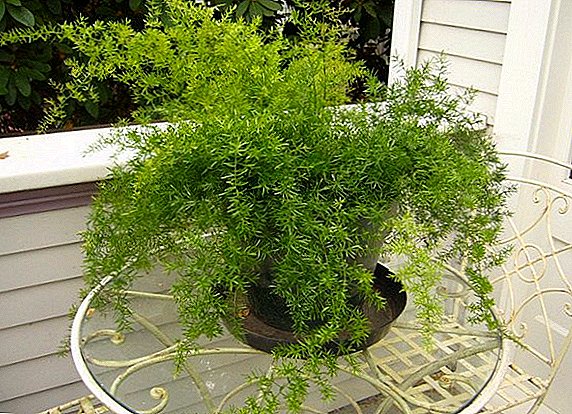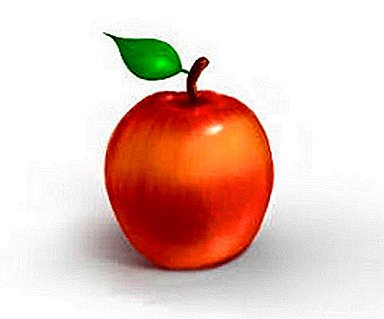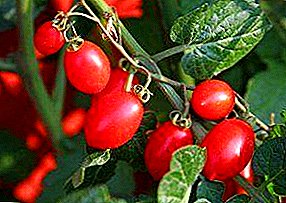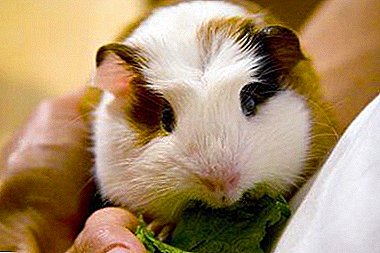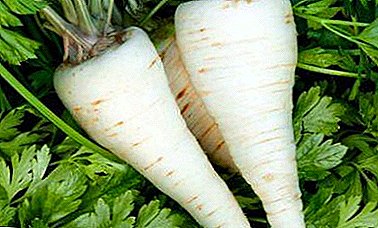
Parsley is a unique and fully edible product with high mineral and vitamin value for humans.
Its unpretentiousness and taste qualities led to a wide spread of culture among gardeners.
Of all the root parsley varieties, the Root Sugar variety has the most enriched composition, pleasant aroma and organoleptic properties.
Grade determination
Sugar root parsley is an early ripe variety with high yield. and the growing season of up to 100 days, which is a subspecies of curly parsley from the umbrella family (celery). The plant belongs to two years, in the first year the roots ripen, in the second - achenes.
Appearance
The lower part of the plant is represented by a thick single root crop of a spindle-shaped or conical shape, white or milky-white, the length reaches 30 centimeters. The upper part of the plant consists of a large strong sheet rosette consisting of two to three dozen dense symmetrical leaves. The leaves have the shape of an elongated triangle, pinnately dissected. The flowers are greenish-yellow saturated color.
A photo
The photo shows what this plant looks like.





Characteristic
- Productivity Up to 3.5 kg of root crops (20,000-35,000 kg per 1 hectare) are harvested from 1 square meter.
- Duration of ripening. Technical maturity of the plant occurs within 90-100 days from sowing (in September).
- The term of sowing. Seeds are sown in April-May.
- Resistance to diseases and pests. Sugar root parsley shows an average resistance to diseases and pests, which depends on environmental conditions, soil composition, care and the presence of neighboring plants.
The variety is subject to the following diseases:
- rust;
- white rot;
- white spot;
- chalcosporosis;
- carrot fly and listabloshka;
- melon aphid.
- The mass of one root. The mass of fruits ranges from 30 to 80 grams.
- Bloom. Flowering occurs in June, ends with the formation of egg-shaped seeds.
- Frost resistance. The plant is not resistant to frost and frost. When sowing for the winter, the survival rate of seeds reaches 50-55 percent.
Differences from other varieties
This variety has the following differences from other varieties:
- All parts of the plant have a pleasant taste.
- All root crops grow equally medium size and shape.
- Not characteristic mnogostostkovost.
- High foliage facilitates harvesting.
- High content of sucrose, vitamins of group B, water, essential oils.
Brief history of selection
The the variety was bred by breeders in the 19th century. After the discovery and cultivation of the parsley root species, many experimental studies were carried out, during which a variety with a pleasant aroma and good taste was found, in which all parts of the plant were suitable for food.
Through years of research, the dignity of the variety was able to be isolated and consolidated at the genetic level, which led to a steady spread of the root sugar parsley among gardeners.
Soil preparation
The soil is prepared from the end of October or at the end of March. The beds dig up one-third of the bayonet of the shovels and apply organic or synthetic fertilizers (preferably based on ash and potassium), get rid of weeds. The soil must be fertile.
If the sowing is carried out in greenhouse conditions, the use of tree-podzolic and slightly loamy soils with regular fertilizer and loosening is allowed.
Where and for how much you can buy seeds?
Seeds can be purchased online with delivery or ordered at gardening stores in Moscow and St. Petersburg. Prices for a bag of seven seeds (2 grams) range from 11 to 19 rublesThe average price is 15 rubles.
Chemical composition
 Vitamins in the plant are as follows:
Vitamins in the plant are as follows:
- B vitamins (thiamine, riboflavin, folic acid, pyridoxine);
- rutin;
- vitamin C;
- retinol;
- Vitamin PP.
Calorie grade is 45 Kcal, the amount of proteins - 3.5 g, fat - 0.5 g, carbohydrates - 9.0 g per 100 grams.
Micro and macro elements are presented:
- zinc;
- iron;
- magnesium compounds;
- potassium;
- phosphorus;
- calcium;
- selenium;
- essential oils.
Application
What can be used in everyday life? Root sugar parsley is used mainly in cooking. Methods of use:
- drying;
- cooking;
- soaring;
- blanching;
- canning of all parts of the plant;
- adding to the finished dishes in fresh form.
It is used to compensate for the deficiency of microelements and vitamins, especially during the period of hypovitaminosis.
Note: This type of parsley is suitable for short-term storage (up to 3-4 months in dried form) and the manufacture of traditional medicine (tinctures, decoctions).
Landing
Sowing is carried out for the winter (in October) or in the spring (in March). Seeds are not recommended for long soaking, as this will lead to low germination and washing of potassium. Perhaps short-term (up to half an hour) soaking seeds in hot water (50-60 degrees), after which they are dried and immediately begin to plant.
- Seeds are sown to a depth of 1.5-2.0 centimeters in the soil, after preparing the same grooves, between which leave a distance of at least 15-20 centimeters.
- Before sowing, sprinkle the ground with lime.
- After sowing, the grooves need to be plentifully watered, covered with earth over the seeds and loosely tamped. Up to 0.5 kg of seeds are sown per square meter.
The most suitable crops, after which, according to the rules of crop rotation, it is necessary to plant this variety - tomatoes, potatoes, all kinds of cabbage, garlic, onions. After the parsley itself, regardless of the variety, it is necessary to plant the seeds only after 3 years. Next to the beds is not recommended to grow dill, carrots.
Below you can see a useful video on how to sow parsley seeds correctly:
Care
To protect against wind and cold, beds must be mulched with humus.
 The care program includes:
The care program includes:
- top dressing;
- thinning and weeding;
- watering;
- loosening the soil;
- weed removal.
Feeding is required up to 5 times during the entire growth period. Potassium fertilizers, ammonium nitrate, ash are preferred.
Watering is carried out 4-5 times during the growing season, taking into account the friability, soil composition and climatic conditions. On 1 square meter use 2 ten-liter buckets of not cold water. Irrigation is desirable to carry out in the morning and evening as the soil dries. Excessive soil moisture and acidification are not allowed. Possible watering with a drip system. Immediately after watering, the soil is loosened and weeds are removed.
Thinning is carried out after emergence of shoots (1-2 leaves) and after two weeks. This is necessary because excess sprouts take away nutrients. Thinning is carried out to a distance of 3-5 centimeters between shoots. After the second thinning (up to 10 cm between shoots), fertilizing is carried out again.
Harvesting and storage
The roots are harvested in early September, dried and stored in dry sand. Part of the root crops can be used on fresh greens in winter. Seeds are harvested as they mature (they should become saturated brown and dry), stored in bags at a temperature of 18-20 degrees and a humidity of 80-85%.
Fight against diseases and pests
Protection and control measures include:
- Compliance with the rules of crop rotation with the return of parsley to the former bed in 3-4 years, exclusion from the precursors of plants affected by rot.
- Selection of healthy seeds and root crops before sowing and planting in the field, cultures of the first and second year should be isolated from each other.
- Heat treatment of seeds before sowing for 30 minutes.
- Spraying of plants with 1% Bordeaux liquid with signs of disease.
- Compliance with the rules of storage of root crops.
Root sugar parsley is an unpretentious care and rich in nutrients culture that can be grown both in the greenhouse and in the open field, which provides a person with essential substances for a whole year, and also makes it possible to decorate any home and holiday dish in the national treatment and prevention of many diseases.



